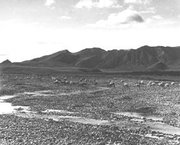Brooks Range Tundra - Polar Desert Province
Contents
Brooks Range Tundra - Polar Desert Province (Bailey)
Northern Alaska, 101,600 mi2 (263,100 km2)
Land-surface form
The Brooks Range, a northern extension of the Rocky Mountains, reaches 600 mi (970 km) westward from Canada to the Chukchi Sea. Its rugged peaks reach elevations of 9,000 ft (2,700 m) in the east, falling to 3,000 ft (900 m) in the west. Broad U-shaped valleys, morainal topography, and braided stream channels show evidence of glaciation. A series of rolling plateaus and low mountains, the arctic foothills, borders the coastal plain to the north.
Climate
The climate of the Brooks Range is similar to that of the arctic coastal plain, but precipitation increases at the higher altitudes and at the east end of the range. Summer temperatures reach 90 to 100F (32 to 38C), and winter temperatures drop as low as -75F (-60C). Because the province lies above the Arctic Circle, it gets several days of 24-hr sunlight (Solar radiation) in June, and several sunless days in December. Precipitation averages 7 to 15 in (180 to 390 mm), but drainage is rapid due to the area's steep slopes and the low holding capacity of its soils.
Vegetation
In the higher alpine areas, plant cover is discontinuous over barren rock. It consists chiefly of low mats of such herbaceous and shrubby species as dwarf arctic birch, crowberry, Labrador-tea, arctic willow, resin birch, and dwarf blueberry. Areas at lower elevations may be covered by a mat of sedge and shrub that provides valuable forage for caribou. Cottongrass, bluejoint, mosses, dwarf willow, dwarf birch, Labrador-tea, and bistort are common. Regeneration is extremely slow for most species; some mosses require more than 60 years to recover from disturbance.
Soils
The mountains are underlain by folded and faulted limestone, the foothills by various sediments. Soils are rocky and poorly developed. Inceptisols cover the lower slopes. Glacial and alluvial deposits occur in the valleys and at the base of the mountain slopes. Permafrost is continuous under the entire area.
Fauna
The Brooks Range is an important big-game area in Alaska, supporting brown and black bear, wolf, wolverine, caribou, and Dall sheep. Smaller mammals include marmot, red and arctic fox, ground squirrel, lemming, and pika.
The Brooks Range is an important resting area for migrating waterfowl and songbirds during summer. Raptors prominent in many areas include golden eagles, marsh hawks, gyrfalcons, and snowy and other open country owls.
Return to Ecoregions of the United States
| Disclaimer: This article is taken wholly from, or contains information that was originally published by, the United States Forest Service. Topic editors and authors for the Encyclopedia of Earth may have edited its content or added new information. The use of information from the United States Forest Service should not be construed as support for or endorsement by that organization for any new information added by EoE personnel, or for any editing of the original content. |
